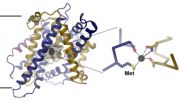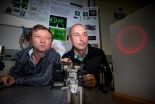(Press-News.org) Individuals who are genetically predisposed to obesity may soon have a therapeutic solution to combat their condition. A research team led by scientists from the National University of Singapore (NUS) has identified several potent inhibitors that selectively target FTO, the common fat mass and obesity-associated gene. These FTO-specific inhibitors pave the way for the development of novel anti-obesity drugs and treatments.
The research, led by Assistant Professor Esther Woon from the Department of Pharmacy at the NUS Faculty of Science, along with colleagues from the Institute of Molecular and Cell Biology (IMCB) at the Agency for Science, Technology and Research (A*STAR), as well as the Nanyang Technological University, is the first to look at potential treatment of obesity from a genetic perspective.
The findings were first published online in the journal Chemical Science on 22 September 2014.
Obesity: A heavy problem
Obesity is not merely a cosmetic problem; it predisposes the individuals to a host of medical conditions such as Type 2 diabetes, cardiovascular diseases and certain cancers. It is estimated that by 2030, about 58 per cent of the world's population will be obese. Singapore shares similar alarming statistics, with 40 per cent of its adult population, aged between 18 and 69, being either overweight or obese.
Despite an urgent need to combat the obesity epidemic, there is currently no safe and effective treatment for obesity. Healthy eating habits and active lifestyle remain important measures in our battle against obesity. However, these efforts are frequently insufficient by themselves due to underlying genetic influences which 'programme' a person's size and appetite.
Among the genetic influences, the FTO gene is one that is strongly linked to obesity, with genome wide studies showing that people with certain variations of the FTO gene are 70 per cent more likely to become obese. This has been shown for both children and adults, as well as across all major ethnic groups, including Chinese, Malay and Indian populations in Singapore.
Currently, there is no safe and effective drug for the long term-treatment of obesity. To address this huge therapeutic gap in medicine, and to explore whether FTO is a probable therapeutic target for obesity, the researchers started to look at developing specific inhibitors of the FTO protein.
"Fat" hope: Potential drug against common obesity gene
In their experiments, the researchers discovered several novel and potent FTO inhibitors, with the strongest being the 4-[N'-(4-Benzyl-pyridine-3-carbonyl)-hydrazino]-4-oxo-but-2-enoic acid. Many of the inhibitors are also able to selectively target FTO over other proteins that are very similar structurally. This discovery was done through an innovative drug discovery strategy called Dynamic Combinatorial Mass-Spectrometry, a method which combines the permutation power of dynamic combinatorial chemistry and the sensitivity of protein mass-spectrometry.
Explained Asst Prof Woon, "Such remarkable selectivity is rarely achieved and is the 'holy grail' in drug discovery, as it potentially translates to significantly reduced side effects. This is demonstrated by the promising activities and low cytotoxicity of some of these inhibitors in cells."
Development of drugs and treatments for obesity and other metabolic diseases
The research team's findings open doors for the development of novel anti-obesity drugs and treatments. They are currently working closely with Associate Professor Tai E Shyong and Assistant Professor Sue-Anne Toh, who are from NUS Yong Loo Lin School of Medicine, as well as Dr Liu Mei Hui of the Food Science and Technology programme at the NUS Faculty of Science, to study the molecular mechanisms and effects of the FTO inhibitors on other closely-related metabolic diseases, such as diabetes. They also hope to secure funding to further their research.
Said Asst Prof Woon, "Recognising a genetic, or even epigenetic, component in obesity certainly changes the way in which we approach to the treatment of the disease. What is so exciting about these FTO inhibitors is that they represent a potential new class of anti-obesity drugs, which target one of the most common genetic causes of obesity."
"Conceivably, if this research comes to fruition, it should benefit a large majority of the population. However, there is still a lot to learn about the actual mechanistic link between FTO and obesity. The challenge now is to uncover the mystery through the use of these selective FTO inhibitors," she added.
The researchers have filed a patent for the inhibitors through the NUS Industry Liaison Office, which is part of NUS Enterprise.
INFORMATION:
In a world of matinee idols and cover girls it's easy to assume that humans want their men to be manly and their women womanly.
But a groundbreaking new study suggests that, rather than being a preference passed down through a long process of social and sexual selection, it's a relatively new habit that has only emerged in modern, urbanised societies.
A team of psychologists, anthropologists and biologists, led by Brunel University London, surveyed 12 populations around the world, from the primitive to the highly developed.
Surprisingly, only in the most industrialised ...
Iron is the most abundant trace element in humans. As a cofactor of certain proteins, it plays an essential role in oxygen transport and metabolism. Due to the major importance of iron in a wide variety of cellular processes, and the harm caused by its uncontrolled accumulation in the body, its uptake and storage is strictly regulated. In mammals, iron is imported into cells by the membrane transport protein DMT1. Mutations of DMT1, which affect its transport properties, lead to iron-related metabolic disorders such as anemia and the iron storage disease hemochromatosis.
Ines ...
How did life originate? And can scientists create life? These questions not only occupy the minds of scientists interested in the origin of life, but also researchers working with technology of the future. If we can create artificial living systems, we may not only understand the origin of life - we can also revolutionize the future of technology.
Protocells are the simplest, most primitive living systems, you can think of. The oldest ancestor of life on Earth was a protocell, and when we see, what it eventually managed to evolve into, we understand why science is so fascinated ...
The drug combination umeclidinium/vilanterol (trade name Anoro) has been approved since May 2014 for adults with chronic obstructive pulmonary disease (COPD). In an early benefit assessment pursuant to the Act on the Reform of the Market for Medicinal Products (AMNOG), the German Institute for Quality and Efficiency in Health Care (IQWiG) examined whether this drug combination offers an added benefit over the appropriate comparator therapy.
According to the findings, an added benefit is not proven: For patients with moderate COPD severity and patients with fewer than ...
Scientists at Nanyang Technological University (NTU Singapore) have discovered a new molecule which can join together chains of amino acids – the building blocks of protein.
Only three other known molecules have been discovered to be able to perform this function, which is an important process in the development of new drugs. A key difference is that the new molecule is able to do the same process 10,000 times faster than the other three and "cleanly" without leaving any residue behind.
This new molecule, which is a type of catalyst or enzyme, was derived from ...
Researchers at VTT Technical Research Centre of Finland, the University of Turku and the University of Oslo have discovered a previously unknown molecular-level mechanism that may partly explain the increased growth of cancer cells. The study, published in the British Journal of Cancer, showed that high levels of miRNA-378a-5p molecule cause cell division anomalies. This renders the number of chromosomes in cancer cells abnormal, which is known to promote growth and the spread of cancer. In addition, the researchers discovered that elevated miRNA378a-5p levels in breast ...
Laser physicists have built a tractor beam that can repel and attract objects, using a hollow laser beam that is bright around the edges and dark in its centre.
It is the first long-distance optical tractor beam and moved particles one fifth of a millimetre in diameter a distance of up to 20 centimetres, around 100 times further than previous experiments.
"Demonstration of a large scale laser beam like this is a kind of holy grail for laser physicists," said Professor Wieslaw Krolikowski, from the Research School of Physics and Engineering at The Australian National ...
What does a 1980s experimental aircraft have to do with state-of-the art quantum technology? Lots, as shown by new research from the Quantum Control Laboratory at the University of Sydney, and published in Nature Physics today.
Over several years a team of scientists has taken inspiration from aerospace research and development programs to make unusually shaped experimental aircraft fly.
"It always amazed me that the X-29, an American airplane that was designed like a dart being thrown backwards, was able to fly. Achieving this, in 1984, came through major advances ...
A pilot study testing a new type of drug in patients with chronic diarrhoea has shown promising effects on reducing their symptoms.
Bile acid diarrhoea (BAD) is a common cause of chronic diarrhoea that is estimated to affect one in 100 adults in western countries, but is often mistaken for irritable bowel syndrome (IBS) by doctors. Many patients are not diagnosed correctly and undergo repeated unnecessary tests.
The study at Imperial College London found that the drug obeticholic acid (OCA) could provide relief for patients with BAD. OCA is the first in a new class ...
Researchers at NYU Langone Medical Center conclude new drug in development may offer first alternative to standard chemotherapy for T-Cell Acute Lymphoblastic Leukemia.
Researchers at NYU Langone Medical Center and elsewhere say that blocking the action of an enzyme "switch" needed to activate tumor growth is emerging as a practical strategy for treating T-cell acute lymphoblastic leukemia.
An estimated quarter of the 500 U.S. adolescents and young adults diagnosed each year with this aggressive disease fail to respond to standard chemotherapy drugs that target cancer ...



